Linking Acoustic Indices to Vegetation and Microclimate in a Historical Urban Garden: Setting the Stage for a Restorative Soundscape
Abstract
1. Introduction
1.1. Research Background
1.2. Soundscape Components and Acoustic Indices
1.3. Ecoacoustic Monitoring Evidence
1.4. Research Significance
2. Materials and Methods
2.1. Study Area
2.2. Acoustic Data Collection
2.3. Calculation of Acoustic Indices
2.4. Microclimatic and Vegetational Variables
2.5. Statistical Analyses
3. Results
3.1. Effects of Season and Environmental Variables on Acoustic Indices
3.2. Acoustic Indices Comparisons According to Seasons
3.3. Spatial Effect on Acoustic Indices
3.4. Differences in Vegetational Metrics Across Recorder Locations
4. Discussion
4.1. Effects of Season and Environmental Variables on Acoustic Indices
4.2. Acoustic Indices Comparisons According to Seasons
4.3. Spatial Effect on Acoustic Indices
4.4. Differences in Vegetational Metrics Across Recorder Locations
4.5. Limitations
5. Conclusions
Author Contributions
Funding
Data Availability Statement
Acknowledgments
Conflicts of Interest
Abbreviations
| Acronym | Full Name | Description |
| AI | Acoustic Indices | Quantitative metrics derived from sound recordings that describe key aspects of the acoustic environment. |
| NDSI | Normalized Difference Soundscape Index | Measures balance between biological and anthropogenic sounds. |
| ACI | Acoustic Complexity Index | Quantifies the complexity of sound based on variations in amplitude across frequencies and time. |
| AEI | Acoustic Evenness Index | Reflects the evenness in the distribution of acoustic energy across frequency bands. |
| ADI | Acoustic Diversity Index | Measures the diversity of frequency bands occupied by sounds, analogous to species diversity. |
| BI | Bioacoustic Index | Estimates the intensity of biological sounds within a target frequency range. |
| CHM | Canopy Height Model | A spatial dataset representing vegetation height above ground, derived from LiDAR data and used as a proxy for vegetation structure. |
Appendix A. Acoustic Indices and Attributes Description
| Index | Soundscape Dimension | Calculation Principle | Parameters/Thresholds | References |
|---|---|---|---|---|
| NDSI(Normalized Difference Soundscape Index) | Biophony vs. anthropophony ratio | , where B = energy in 2–8 kHz, A = energy in 1–2 kHz | Frequency bands empirically set to distinguish anthropogenic and biological components | Pijanowski et al., 2011, [2] |
| ACI (Acoustic Complexity Index) | Temporal variability of biophonic activity | Sum of amplitude differences across consecutive time steps in each frequency bin | Frame length (e.g., 512), step size; sensitive to avian activity patterns | Pieretti et al., 2011, [44] |
| AEI (Acoustic Evenness Index) | Spectral evenness and dominance | Gini coefficient of the distribution of energy across frequency bins | Calculated on normalized amplitudes in fixed bands (e.g., 1 kHz) | Villanueva-Rivera et al., 2011, [50] |
| ADI (Acoustic Diversity Index) | Spectral entropy and diversity | Shannon diversity index based on energy levels in frequency bins | Number of frequency bands (e.g., 1 kHz); assumes higher diversity = more taxa | Villanueva-Rivera et al., 2011, [50] |
| BI (Bioacoustic Index) | Biotic acoustic activity (intensity) | Summed amplitude in the biophonic range (typically 2–8 kHz) | Amplitude thresholding applied to filter background noise | Boelman et al., 2007, [53] |
Appendix B. Vegetational Metrics Description and Statistics
| Species | N of Individuals | Proportion (%) |
|---|---|---|
| Taxus baccata L. | 304 | 23.4 |
| Carpinus betulus L. | 192 | 14.8 |
| Acer campestre L. | 143 | 11.0 |
| Ulmus minor Miller | 133 | 10.2 |
| Celtis australis L. | 118 | 9.1 |
| Celtis occidentalis L. | 43 | 3.3 |
| Ligustrum lucidum Ait. fil. | 38 | 2.9 |
| Tilia platyphyllos Scop. | 36 | 2.8 |
| Cedrus deodara G. Don | 31 | 2.4 |
| Robinia pseudoacacia L. | 29 | 2.2 |
| Fraxinus excelsior L. | 27 | 2.1 |
| Quercus robur L. | 26 | 2.0 |
| Acer pseudoplatanus L. | 18 | 1.4 |
| Quercus ilex L. | 13 | 1.0 |
| Photinia serrulata Lindl. | 11 | 0.8 |
| Magnolia grandiflora L. | 10 | 0.8 |
| Morus alba L. | 10 | 0.8 |
| Prunus spinosa L. | 9 | 0.7 |
| Tilia x vulgaris Hayne | 9 | 0.7 |
| Aesculus hippocastanum L. | 8 | 0.6 |
| Platanus hybrida Brot. | 8 | 0.6 |
| Fraxinus angustifolia Vahl | 7 | 0.5 |
| Picea abies (L.) Karst | 7 | 0.5 |
| Crataegus monogyna Jacq. | 6 | 0.5 |
| Morus nigra L. | 5 | 0.4 |
| Cryptomeria japonica D. Don | 4 | 0.3 |
| Ailanthus altissima Swingle | 3 | 0.2 |
| Gleditschia triacanthos L. | 3 | 0.2 |
| Pinus nigra Arnold | 3 | 0.2 |
| Sambucus nigra L. | 3 | 0.2 |
| Taxodium disticum (L.) Rich. | 3 | 0.2 |
| Abies alba Miller | 2 | 0.2 |
| Diospyros virginiana L. | 2 | 0.2 |
| Osmanthus decorus (Boiss. e Bal.) | 2 | 0.2 |
| Popolus alba | 2 | 0.2 |
| Populus nigra L. | 2 | 0.2 |
| Sophora japonica L. | 2 | 0.2 |
| Sophora japonica L. var. pendula | 2 | 0.2 |
| Thuja occidentalis L. | 2 | 0.2 |
| Tilia cordata Miller | 2 | 0.2 |
| Acer negundo L. | 1 | 0.1 |
| Acer platanoides L. | 1 | 0.1 |
| Alnus glutinosa (L.) Gaertner | 1 | 0.1 |
| Cedrus atlantica Carriere | 1 | 0.1 |
| Cephalotaxus fortunei (Knight) | 1 | 0.1 |
| Cercis Siliquastum | 1 | 0.1 |
| Chamaecyparis lawsoniana (Parl.) | 1 | 0.1 |
| Cupressus lusitanica Miller | 1 | 0.1 |
| Cupressus sempervirens L. | 1 | 0.1 |
| Fraxinus ornus L. | 1 | 0.1 |
| Ginkgo biloba L. | 1 | 0.1 |
| Gymnocladus dioicus Koch | 1 | 0.1 |
| Lagerstroemia indica L. | 1 | 0.1 |
| Larix decidua Miller | 1 | 0.1 |
| Ligustrum ovalifolium Hassk. | 1 | 0.1 |
| Liquidambar orientalis Mill. | 1 | 0.1 |
| Magnolia soulangeana Soul. | 1 | 0.1 |
| Pinus strobus L. | 1 | 0.1 |
| Populus nigra L. var. italica | 1 | 0.1 |
| Prunus avium L. | 1 | 0.1 |
| Trachycarpus fortunei (Hooker) Wendl. | 1 | 0.1 |
| Statistic | Height (m) | Diameter (cm) |
|---|---|---|
| Mean | 14.98 | 26.89 |
| Median | 15.00 | 24.00 |
| Standard Deviation | 5.20 | 20.33 |
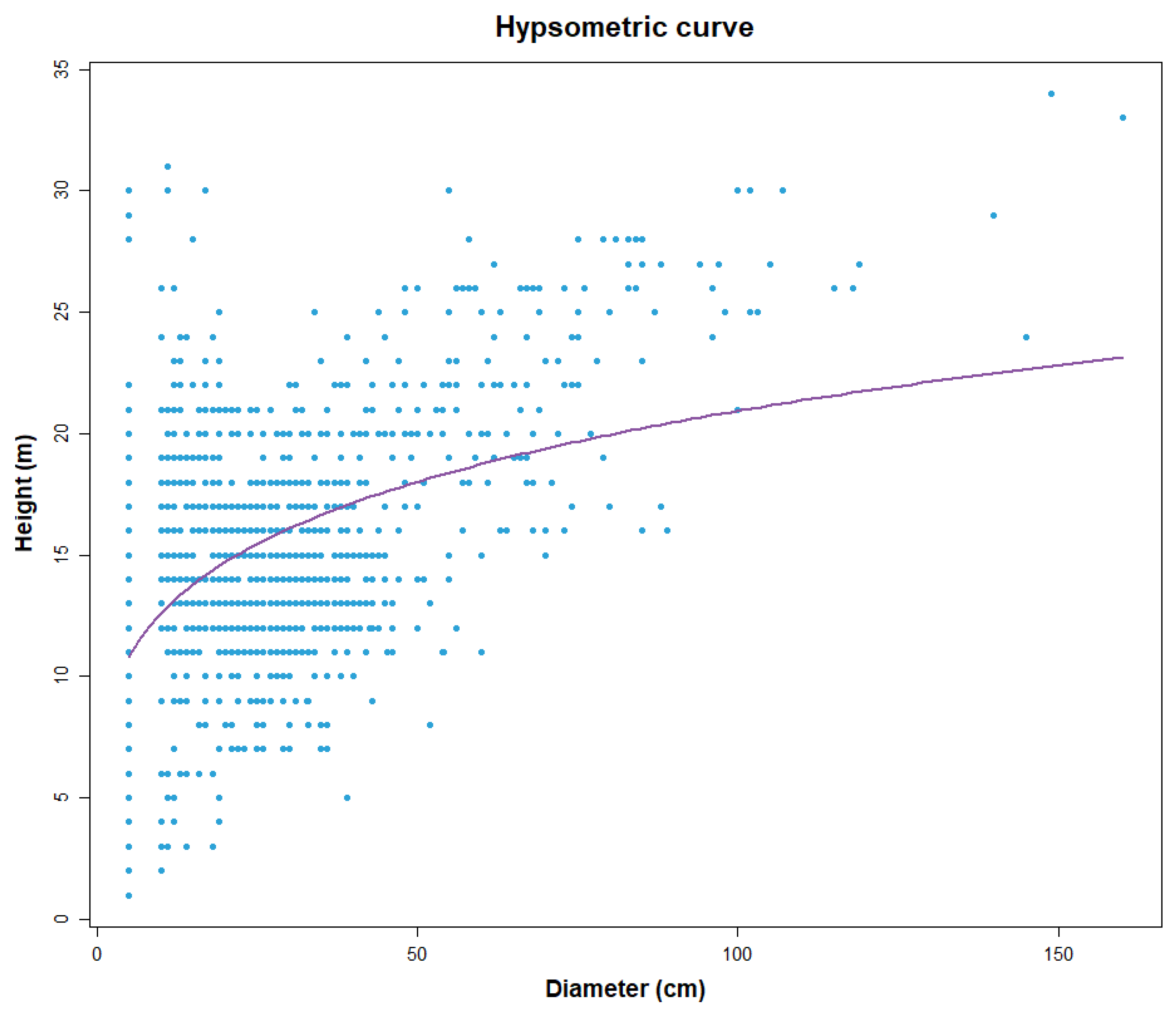
Appendix C. Vegetation Metrics’ Spatial Variation Analysis Results
| Comparison | Z-Score | Adjusted p-Value | Significance |
|---|---|---|---|
| CHM | |||
| P1 vs. P2 | −20.0 | 2.58 × | *** |
| P1 vs. P3 | −60.0 | 0 | *** |
| P1 vs. P4 | −40.1 | 0 | *** |
| P2 vs. P3 | −40.0 | 0 | *** |
| P2 vs. P4 | −20.0 | 4.69 × | *** |
| P3 vs. P4 | 20.0 | 2.57 × | *** |
| Tree Density | |||
| P1 vs. P2 | −20.0 | 2.58 × | *** |
| P1 vs. P3 | −60.0 | 0 | *** |
| P1 vs. P4 | −40.1 | 0 | *** |
| P2 vs. P3 | −40.0 | 0 | *** |
| P2 vs. P4 | −20.0 | 4.69 × | *** |
| P3 vs. P4 | 20.0 | 2.57 × | *** |
| Number of species | |||
| P1 vs. P2 | −63.3 | 0 | *** |
| P1 vs. P3 | −31.7 | 1.09 × | *** |
| P1 vs. P4 | −31.7 | 5.11 × | *** |
| P2 vs. P3 | 31.6 | 6.45 × | *** |
| P2 vs. P4 | 31.6 | 3.06 × | *** |
| P3 vs. P4 | 0 | 1 | |
| Proportion of evergreen species | |||
| P1 vs. P2 | −20.0 | 2.58 × | *** |
| P1 vs. P3 | 40.1 | 0 | *** |
| P1 vs. P4 | 20.1 | 5.70 × | *** |
| P2 vs. P3 | 60.0 | 0 | *** |
| P2 vs. P4 | 40.1 | 0 | *** |
| P3 vs. P4 | −20.0 | 2.57 × | *** |
| Mean basal area (m2) | |||
| P1 vs. P2 | −20.0 | 2.58 × | *** |
| P1 vs. P3 | 40.1 | 0 | *** |
| P1 vs. P4 | 20.1 | 5.70 × | *** |
| P2 vs. P3 | 60.0 | 0 | *** |
| P2 vs. P4 | 40.1 | 0 | *** |
| P3 vs. P4 | −20.0 | 2.57 × | *** |
References
- Krause, B.L. The niche hypothesis: A hidden symphony of animal sounds, the origins of musical expression and the health of habitats. Soundscape Newsl. 1993, 6, 6–10. [Google Scholar]
- Pijanowski, B.C.; Villanueva-Rivera, L.J.; Dumyahn, S.L.; Farina, A.; Krause, B.L.; Napoletano, B.M.; Gage, S.H.; Pieretti, N. Soundscape ecology: The science of sound in the landscape. BioScience 2011, 61, 203–216. [Google Scholar] [CrossRef]
- Francis, C.D.; Kleist, N.J.; Ortega, C.P.; Cruz, A. Anthropogenic noise pollution: A novel risk factor for avian populations. Behav. Ecol. 2017, 28, 949–957. [Google Scholar] [CrossRef]
- Hedblom, M.; Heyman, E.; Antonsson, H.; Gunnarsson, B. Bird song diversity influences young people’s appreciation of urban landscapes. Urban For. Urban Green. 2014, 13, 469–474. [Google Scholar] [CrossRef]
- Zhao, Y.; Kang, J.; Torija, A.J. Vegetation structure and urban noise attenuation: Evaluating the role of green infrastructure in shaping restorative soundscapes. Urban For. Urban Green. 2025, 81, 127151. [Google Scholar]
- Truax, B. The World Soundscape Project; Simon Fraser University: Burnaby, BC, Canada, 1978. [Google Scholar]
- Fuller, R.A.; Gaston, K.J.; Irvine, K.N. Psychological benefits of green space increase with biodiversity. Biol. Lett. 2015, 3, 390–394. [Google Scholar] [CrossRef]
- Schafer, R.M. The Soundscape: Our Sonic Environment and the Tuning of the World; Destiny Books: Rochester, VT, USA, 1994. [Google Scholar]
- Joo, W.; Napoletano, B.; Qi, J.; Gage, S.; Biswas, S. Soundscape Characteristics of An Environment A New Ecological Indicator of Ecosystem Health. In Wetland and Water Resource Modeling and Assessment—A Watershed Perspective; CRC Press: Boca Raton, FL, USA, 2007; pp. 201–211. [Google Scholar]
- Benocci, R.; Brambilla, G.; Bisceglie, A.; Zambon, G. Sound ecology indicators applied to urban parks: A preliminary study. Asia-Pac. J. Sci. Technol. 2020, 25, 1–10. [Google Scholar]
- Depraetere, M.; Pavoine, S.; Jiguet, F.; Gasc, A.; Duvail, S.; Sueur, J. Monitoring animal diversity using acoustic indices: Implementation in a temperate woodland. Ecol. Indic. 2012, 13, 46–54. [Google Scholar] [CrossRef]
- Gasc, A.; Sueur, J.; Jiguet, F.; Devictor, V.; Grandcolas, P.; Burrow, C.; Depraetere, M.; Pavoine, S. Assessing biodiversity with sound: Do acoustic diversity indices reflect phylogenetic and functional diversity? Ecol. Indic. 2016, 61, 658–667. [Google Scholar] [CrossRef]
- Farina, A.; Gage, S.H. Ecoacoustics: The Ecological Role of Sounds; John Wiley & Sons: Hoboken, NJ, USA, 2017. [Google Scholar] [CrossRef]
- Benocci, R.; Brambilla, G.; Bisceglie, A.; Zambon, G. Eco-acoustic indices to evaluate soundscape degradation due to human intrusion. Sustainability 2020, 12, 10455. [Google Scholar] [CrossRef]
- Sueur, J.; Farina, A.; Gasc, A.; Pieretti, N.; Pavoine, S. Acoustic indices for biodiversity assessment and landscape investigation. Acta Acust. United Acust. 2014, 100, 772–781. [Google Scholar] [CrossRef]
- Rajan, S.C.; Athira, K.; Jaishanker, R.; Sooraj, N.; Sarojkumar, V. Rapid assessment of biodiversity using acoustic indices. Biodivers. Conserv. 2019, 28, 2371–2383. [Google Scholar] [CrossRef]
- Righini, R.; Pavan, G. A soundscape assessment of the Sasso Fratino integral nature reserve in the Central Apennines, Italy. Biodiversity 2020, 21, 4–14. [Google Scholar] [CrossRef]
- Guagliumi, G.; Canedoli, C.; Potenza, A.; Zaffaroni-Caorsi, V.; Benocci, R.; Padoa-Schioppa, E.; Zambon, G. Unraveling Soundscape Dynamics: The Interaction Between Vegetation Structure and Acoustic Patterns. Sustainability 2025, 17, 4204. [Google Scholar] [CrossRef]
- Yang, W.; Kang, J. Soundscape and sound preferences in urban squares: A case study in Sheffield. J. Urban Des. 2005, 10, 61–80. [Google Scholar] [CrossRef]
- Gasc, A.; Francomano, D.; Dunning, J.B.; Pijanowski, B.C. Future directions for soundscape ecology: The importance of defining metrics for community-level acoustic patterns. Bioacoustics 2015, 24, 289–297. [Google Scholar]
- Fisher, J.C.; Irvine, K.N.; Bicknell, J.E.; Hayes, W.M.; Fernandes, D.; Mistry, J.; Davies, Z.G. Perceived biodiversity, sound, naturalness and safety enhance the restorative quality and wellbeing benefits of green and blue space in a neotropical city. Sci. Total Environ. 2021, 755, 143095. [Google Scholar] [CrossRef]
- Hao, Z.; Wang, C.; Sun, Z.; Zhao, D.; Sun, B.; Wang, H.; van den Bosch, C.K. Vegetation structure and temporality influence the dominance, diversity, and composition of forest acoustic communities. For. Ecol. Manag. 2021, 482, 118871. [Google Scholar] [CrossRef]
- Dumyahn, S.L.; Pijanowski, B.C. Soundscape conservation. Landsc. Ecol. 2011, 26, 1327–1344. [Google Scholar] [CrossRef]
- Buxton, R.T.; McKenna, M.F.; Mennitt, D.; Brown, E.; Fristrup, K.M.; Crooks, K.; Angeloni, L.; Wittemyer, G. Noise pollution is pervasive in U.S. protected areas. Science 2018, 356, 531–533. [Google Scholar] [CrossRef]
- Holgate, B.; Maggini, R.; Fuller, S. Mapping ecoacoustic hot spots and moments of biodiversity to inform conservation and urban planning. Ecol. Indic. 2021, 126, 107627. [Google Scholar] [CrossRef]
- Gibb, R.; Browning, E.; Glover-Kapfer, P.; Jones, K.E. Emerging opportunities and challenges for passive acoustics in ecological assessment and monitoring. Methods Ecol. Evol. 2019, 10, 169–185. [Google Scholar] [CrossRef]
- Fairbrass, A.J.; Rennert, P.; Williams, C.; Titheridge, H.; Jones, K.E. City-wide acoustic monitoring reveals biotic and anthropogenic sound patterns in an urban landscape. Landsc. Urban Plan. 2017, 162, 178–186. [Google Scholar] [CrossRef]
- Fairbrass, A.J.; Rennert, P.; Williams, C.; Titheridge, H.; Jones, K.E. Biases of acoustic indices measuring biodiversity in urban areas. Ecol. Indic. 2017, 83, 169–177. [Google Scholar] [CrossRef]
- European Parliament and Council. Directive 2002/49/EC of the European Parliament and of the Council of 25 June 2002 Relating to the Assessment and Management of Environmental Noise. Official Journal of the European Union, L 189/12, 18.07.2002. 2002. Available online: https://eur-lex.europa.eu/eli/dir/2002/49/oj (accessed on 28 June 2025).
- Somervuo, P.; Roslin, T.; Fisher, B.; Hardwick, B.; Kerdraon, D.; Raharinjanahary, D.; Mata, V. Human contributions to global soundscapes are less predictable than the acoustic rhythms of wildlife. Nat. Ecol. Evol. 2025, 9, 1585–1598. [Google Scholar] [CrossRef]
- Bian, Q.; Wang, C.; Cheng, H.; Han, D.; Zhao, Y.; Yin, L. Exploring the application of acoustic indices in the assessment of bird diversity in urban forests. Ecol. Indic. 2022, 144, 109528. [Google Scholar] [CrossRef]
- Lei, C.; Zhiyong, X.; Pukun, S.; Xiaotian, L.; Zhao, Z. Exploring the application of frequency-dependent acoustic diversity index in human-dominated areas. Biodivers. Sci. 2024, 32, 24286. [Google Scholar] [CrossRef]
- Santos, E.; Wiederhecker, H.; Pompermaier, V.; Schirmer, S.; Gainsbury, A.; Marini, M. Are acoustic indices useful for monitoring urban biodiversity? Urban Ecosyst. 2024, 27, 1975–1981. [Google Scholar] [CrossRef]
- Haselhoff, T.; Schuck, M.; Lawrence, B.T.; Fiebig, A.; Moebus, S. Characterizing acoustic dimensions of health-related urban greenspace. Ecol. Indic. 2024, 166, 112547. [Google Scholar] [CrossRef]
- Buxton, R.T.; Agnihotri, S.; Robin, V.; Goel, A.; Balakrishnan, R. Acoustic indices as rapid indicators of avian diversity in different land-use types in an Indian biodiversity hotspot. J. Ecoacoustics 2018, 2, 8. [Google Scholar] [CrossRef]
- Xiang, Y.; Meng, Q.; Zhang, X.; Li, M.; Yang, D.; Wu, Y. Soundscape diversity: Evaluation indices of the sound environment in urban green spaces–Effectiveness, role, and interpretation. Ecol. Indic. 2023, 154, 110725. [Google Scholar] [CrossRef]
- Alcocer, I.; Lima, H.; Sugai, L.S.M.; Llusia, D. Acoustic indices as proxies for biodiversity: A meta-analysis. Biol. Rev. 2022, 97, 2209–2236. [Google Scholar] [CrossRef] [PubMed]
- Araujo, A.; Machado, R. Acoustic communities in an environmental gradient from native to urban areas in Central Brazil. Austral Ecol. 2023, 48, 1941–1960. [Google Scholar] [CrossRef]
- Diaz, S.D.U.; Gan, J.L.; Tapang, G.A. Acoustic indices as proxies for bird species richness in an urban green space in Metro Manila. PLoS ONE 2023, 18, e0289001. [Google Scholar] [CrossRef] [PubMed]
- Sella, E.; Meneghetti, C.; Muffato, V.; Borella, E.; Carbone, E.; Cavalli, R.; Pazzaglia, F. The influence of individual characteristics on perceived restorativeness and benefits associated with exposure to nature in a garden. Front. Psychol. 2023, 14, 1130915. [Google Scholar] [CrossRef]
- Darras, K.; Batáry, P.; Furnas, B.; Celis-Murillo, A.; Van Wilgenburg, S.L.; Mulyani, Y.A. Comparative effectiveness of acoustic indices for biodiversity monitoring in complex tropical landscapes. Ecol. Indic. 2018, 85, 117–126. [Google Scholar] [CrossRef]
- Hyland, E.B.; Schulz, A.; Quinn, J.E. Quantifying the Soundscape: How filters change acoustic indices. Ecol. Indic. 2023, 148, 110061. [Google Scholar] [CrossRef]
- Joo, W.; Gage, S.H.; Kasten, E.P. Analysis and interpretation of variability in soundscapes along an urban–rural gradient. Landsc. Urban Plan. 2011, 103, 259–276. [Google Scholar] [CrossRef]
- Pieretti, N.; Farina, A.; Morri, D. A new methodology to infer the singing activity of an avian community: The Acoustic Complexity Index (ACI). Ecol. Indic. 2011, 11, 868–873. [Google Scholar] [CrossRef]
- Sueur, J.; Farina, A. Ecoacoustics: The ecological investigation and interpretation of environmental sound. Biosemiotics 2015, 8, 493–502. [Google Scholar] [CrossRef]
- Farina, A.; Pieretti, N. Soundscape Ecology: Principles, Patterns, Methods and Applications; Springer: Berlin/Heidelberg, Germany, 2014. [Google Scholar] [CrossRef]
- Shannon, C.E. A Mathematical Theory of Communication. Bell Syst. Tech. J. 1948, 27, 379–423. [Google Scholar] [CrossRef]
- Legendre, P.; Legendre, L. Numerical Ecology; Elsevier: Amsterdam, The Netherlands, 1998. [Google Scholar]
- Magurran, A.E. Measuring Biological Diversity; Blackwell Publishing: Oxford, UK, 2004. [Google Scholar]
- Villanueva-Rivera, L.J.; Pijanowski, B.C.; Doucette, J.; Pekin, B. A primer of acoustic analysis for landscape ecologists. Landsc. Ecol. 2011, 26, 1233–1246. [Google Scholar] [CrossRef]
- Krause, B. The Great Animal Orchestra: Finding the Origins of Music in the World’s Wild Places; Little, Brown and Company: New York, NY, USA, 2012. [Google Scholar]
- Gini, C.W. Variability and mutability, contribution to the study of statistical distributions and relations. Studi Econ.-Giuridici R Univ. Cagliari 1912. [Google Scholar]
- Boelman, N.T.; Asner, G.P.; Hart, P.J.; Martin, R.E. Multi-trophic invasion resistance in Hawaii: Bioacoustics, field surveys, and remote sensing. Ecol. Appl. 2007, 17, 2137–2144. [Google Scholar] [CrossRef]
- Kasten, E.P.; Gage, S.H.; Fox, J.; Joo, W. The remote environmental assessment laboratory’s acoustic library: An archive for studying soundscape ecology. Ecol. Inform. 2012, 12, 50–67. [Google Scholar] [CrossRef]
- August, P.V. Environmental sound propagation and landscape heterogeneity: Linking acoustic ecology with ecoacoustics. Ecol. Indic. 2021, 122, 107301. [Google Scholar] [CrossRef]
- Pirotti, F.; Piragnolo, M.; Vettore, A.; Guarnieri, A. Comparing accuracy of ultra-dense laser scanner and photogrammetry point clouds. Int. Arch. Photogramm. Remote Sens. Spat. Inf. Sci. 2022, 43, 353–359. [Google Scholar] [CrossRef]
- Farina, A.; Pieretti, N.; Piccioli, L. The soundscape methodology for long-term bird monitoring: A Mediterranean Europe case-study. Ecol. Informatics 2014, 21, 4–15. [Google Scholar] [CrossRef]
- Remme, R.P.; Hein, L.; van Swaay, C.A. Exploring spatial indicators for biodiversity accounting. Ecol. Indic. 2016, 70, 232–248. [Google Scholar] [CrossRef]
- Okabe, A.; Satoh, T.; Furuta, T.; Suzuki, A.; Okano, K. Generalized network Voronoi diagrams: Concepts, computational methods, and applications. Int. J. Geogr. Inf. Sci. 2008, 22, 965–994. [Google Scholar] [CrossRef]
- Bates, D.; Maechler, M.; Bolker, B.; Walker, S.; Christensen, R.H.B.; Singmann, H.; Dai, B.; Grothendieck, G.; Green, P.; Bolker, M.B. Package ‘lme4’. Convergence 2015, 12, 2. [Google Scholar]
- R Core Team. R: A Language and Environment for Statistical Computing; Version 4.3.1; R Foundation for Statistical Computing: Vienna, Austria, 2023. [Google Scholar]
- Fox, J.; Weisberg, S. An R Companion to Applied Regression; Sage Publications: Thousand Oaks, CA, USA, 2018. [Google Scholar]
- Nakagawa, S.; Schielzeth, H. A general and simple method for obtaining R2 from generalized linear mixed-effects models. Methods Ecol. Evol. 2013, 4, 133–142. [Google Scholar] [CrossRef]
- Lüdecke, D.; Ben-Shachar, M.S.; Patil, I.; Waggoner, P.; Makowski, D. Performance: An R package for assessment, comparison and testing of statistical models. J. Open Source Softw. 2021, 6. [Google Scholar] [CrossRef]
- Lenth, R.; Singmann, H.; Love, J.; Buerkner, P.; Herve, M. Emmeans: Estimated marginal means. AKA Least-Squares Means 2018, 1. [Google Scholar]
- Razali, N.M.; Wah, Y.B. Power comparisons of shapiro-wilk, kolmogorov-smirnov, lilliefors and anderson-darling tests. J. Stat. Model. Anal. 2011, 2, 21–33. [Google Scholar]
- Kruskal, W.H.; Wallis, W.A. Use of ranks in one-criterion variance analysis. J. Am. Stat. Assoc. 1952, 47, 583–621. [Google Scholar] [CrossRef]
- Dinno, A. Nonparametric pairwise multiple comparisons in independent groups using Dunn’s test. Stata J. 2015, 15, 292–300. [Google Scholar] [CrossRef]
- Farina, A.; Lattanzi, E.; Malavasi, R.; Pieretti, N.; Piccioli, L. Avian soundscapes and cognitive landscapes: Theory, application and ecological perspectives. Landsc. Ecol. 2011, 26, 1257–1267. [Google Scholar] [CrossRef]
- Darras, K.; Furnas, B.; Fitriawan, I.; Mulyani, Y.; Tscharntke, T. Estimating biodiversity with sound: Optimizing sampling effort of ecoacoustic indices. Ecol. Indic. 2016, 66, 555–564. [Google Scholar]
- Gasc, A.; Sueur, J.; Jiguet, F.; Devictor, V.; Grandcolas, P.; Burrow, A.L.; Depraetere, M.; Pavoine, S. Assessing biodiversity with sound: Do acoustic diversity indices reflect phylogenetic and functional diversities of bird communities? Ecol. Indic. 2013, 25, 279–287. [Google Scholar] [CrossRef]
- Mullet, T.C.; Kight, C.R.; Swaddle, J.P. Urban noise affects perception of risk in songbirds. Urban Ecosyst. 2016, 19, 1395–1402. [Google Scholar]
- García, R.G.; Brambilla, M.; Laiolo, P. Integrating LiDAR and acoustic indices to understand habitat complexity and biodiversity patterns in forests. Ecol. Appl. 2021, 31, e02317. [Google Scholar]
- Duarte, M.H.L.; Sousa-Lima, R.S.; Young, R.J. Monitoring free-ranging wildlife in urban landscapes: Using acoustic recordings to detect species presence. Urban Ecosyst. 2018, 21, 1169–1180. [Google Scholar]
- Bradfer-Lawrence, T.; Gardner, K.; Bunnefeld, D.; Willis, S.G.; Edwards, D.P. Guidelines for the use of passive acoustic recorders to monitor animal populations. Ecol. Indic. 2020, 115, 106412. [Google Scholar] [CrossRef]
- Darras, K.; Schmidt, H.P.; Römer, T.; Müller, D.; Tscharntke, T. Measuring sound detection spaces for acoustic animal sampling and monitoring. Biol. Conserv. 2016, 201, 29–37. [Google Scholar] [CrossRef]
- Fuller, R.A.; Warren, P.H.; Gaston, K.J. Daytime noise predicts nocturnal singing in urban robins. Biol. Lett. 2007, 3, 368–370. [Google Scholar] [CrossRef] [PubMed]
- Gasc, A.; Sueur, J.; Jiguet, F.; Devigne, C. Soundscapes in four European cities: Noise monitoring, health impacts, and practical applications. Ecol. Indic. 2016, 72, 746–756. [Google Scholar] [CrossRef]
- Sánchez, M.L.; Barbosa, O.; Bustamante, R.O. Vegetation structure modulates the perception of noise pollution in urban parks. Urban For. Urban Green. 2020, 47, 126561. [Google Scholar] [CrossRef]
- Smith, N.; Pijanowski, B.C.; Gage, S.H. Acoustic indices predict biodiversity and human perception of soundscapes in urban green spaces. Ecol. Indic. 2020, 116, 106495. [Google Scholar] [CrossRef]
- Farina, A.; James, P. The ecoacoustic event detection: A new method for index development and soundscape analysis. Ecol. Informatics 2016, 31, 25–33. [Google Scholar] [CrossRef]
- Reed, S.E.; Boggs, J.L.; Mann, J.P. A GIS tool for modeling anthropogenic noise propagation in natural ecosystems. Environ. Model. Softw. 2012, 37, 1–5. [Google Scholar] [CrossRef]
- Zhou, Z.; Yang, L.; Zhang, Y. Vegetation structure influences sound transmission and attenuation in urban parks. Urban For. Urban Green. 2020, 48, 126520. [Google Scholar] [CrossRef]
- Slabbekoorn, H.; Ripmeester, E.A.P. Birdsong and anthropogenic noise: Implications and applications for conservation. Mol. Ecol. 2008, 17, 72–83. [Google Scholar] [CrossRef]
- Pekin, B.; Jung, J.; Villanueva-Rivera, L.; Pijanowski, B.; Ahumada, J. Modeling acoustic diversity using soundscape recordings and LIDAR-derived metrics of vertical forest structure in a neotropical rainforest. Landsc. Ecol. 2012, 7, 1513–1522. [Google Scholar]
- Brambilla, M.; Galli, L. Soundscapes in urban parks: Ecological meaning and perceptual implications. Urban For. Urban Green. 2021, 64, 127266. [Google Scholar] [CrossRef]
- Richards, F.J. A flexible growth function for empirical use. J. Exp. Bot. 1959, 10, 290–301. [Google Scholar] [CrossRef]
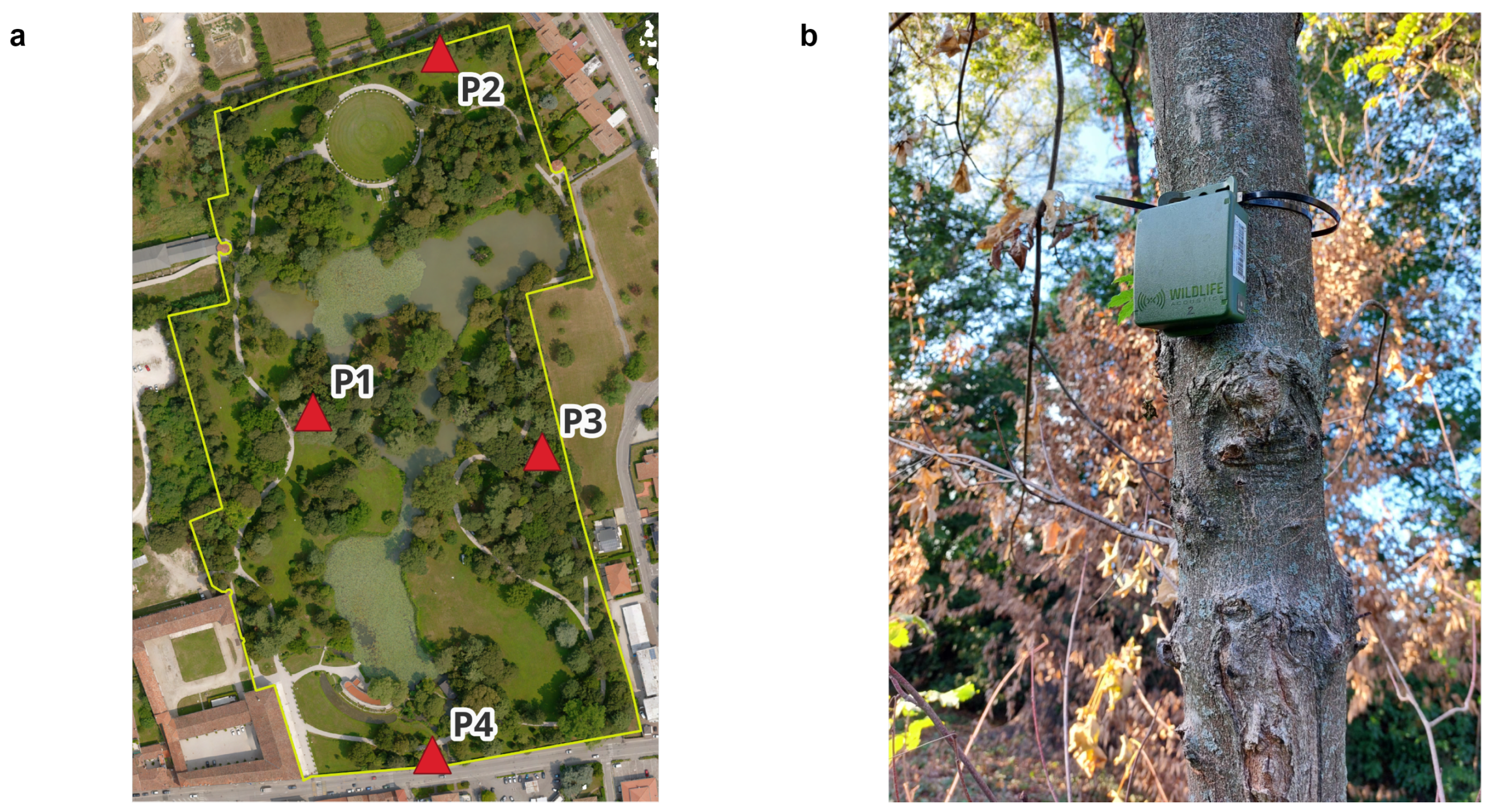
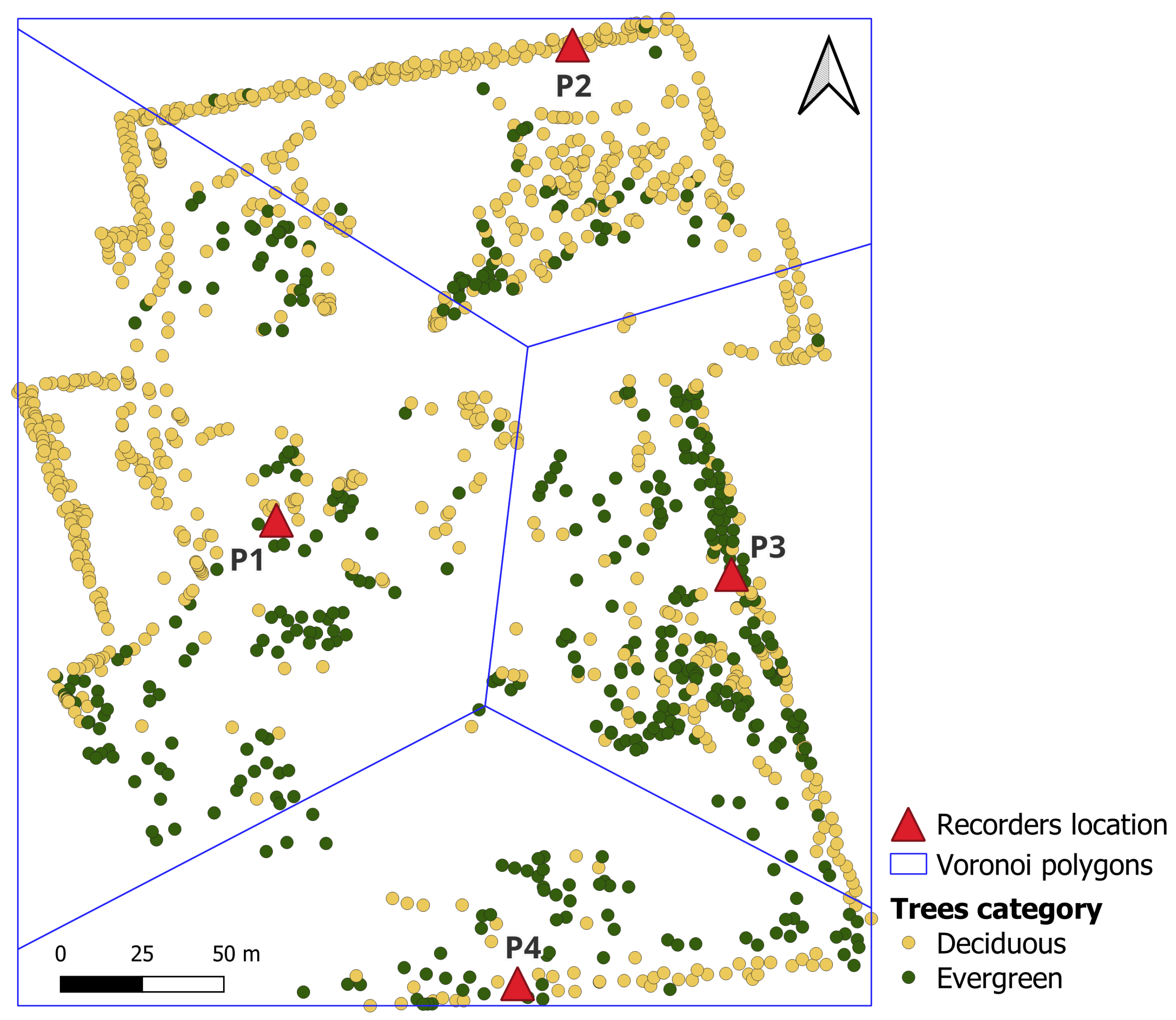
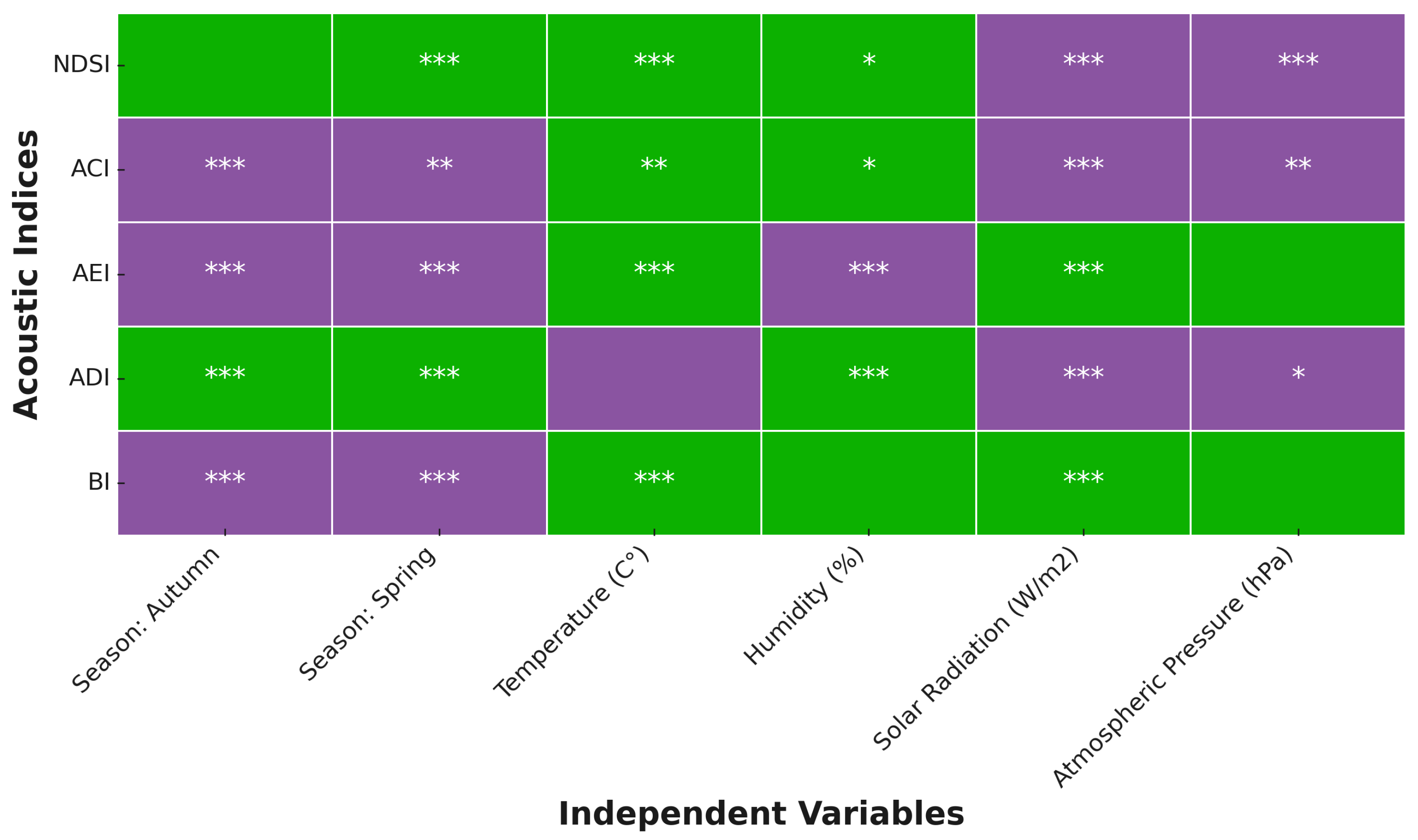
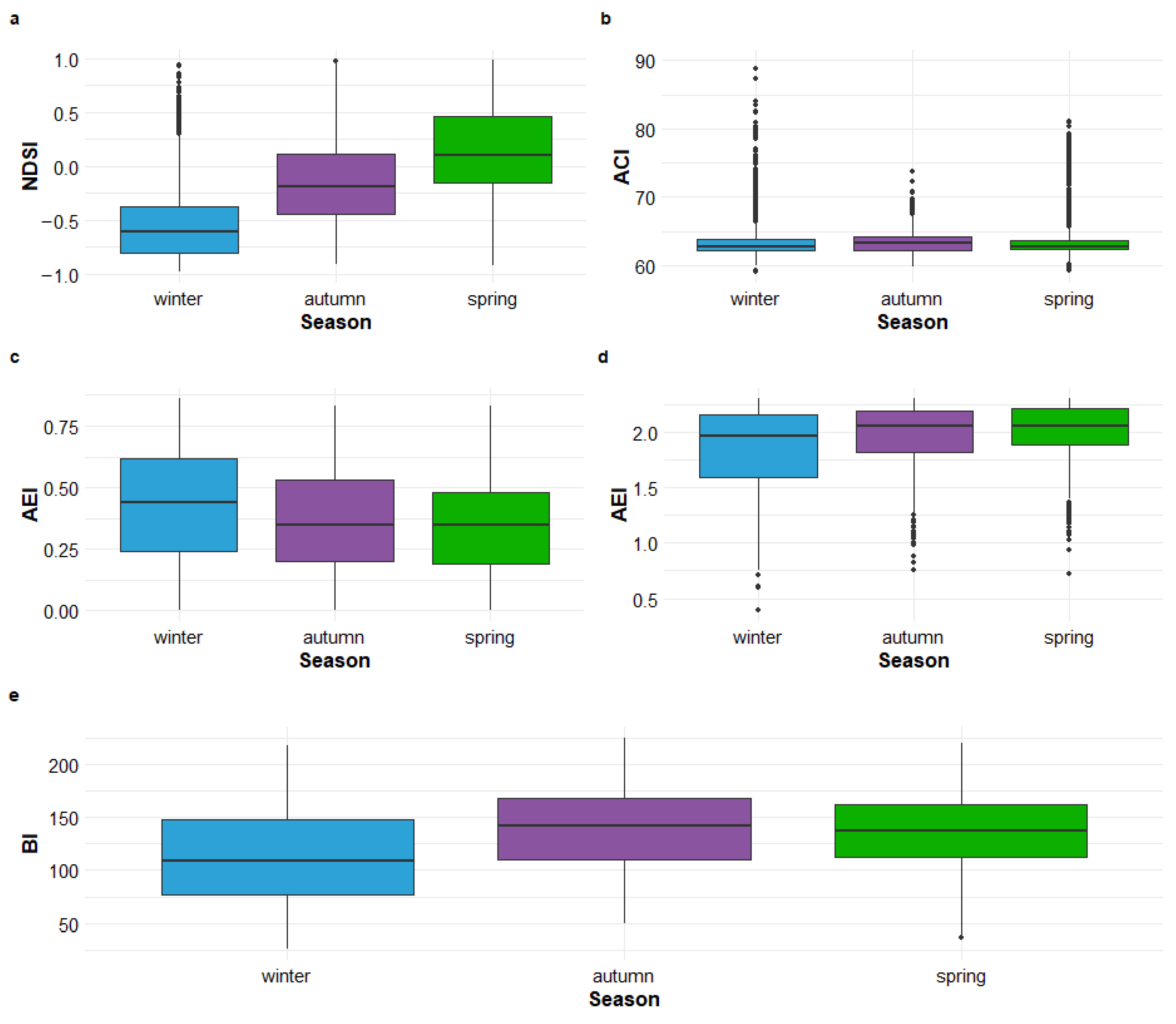
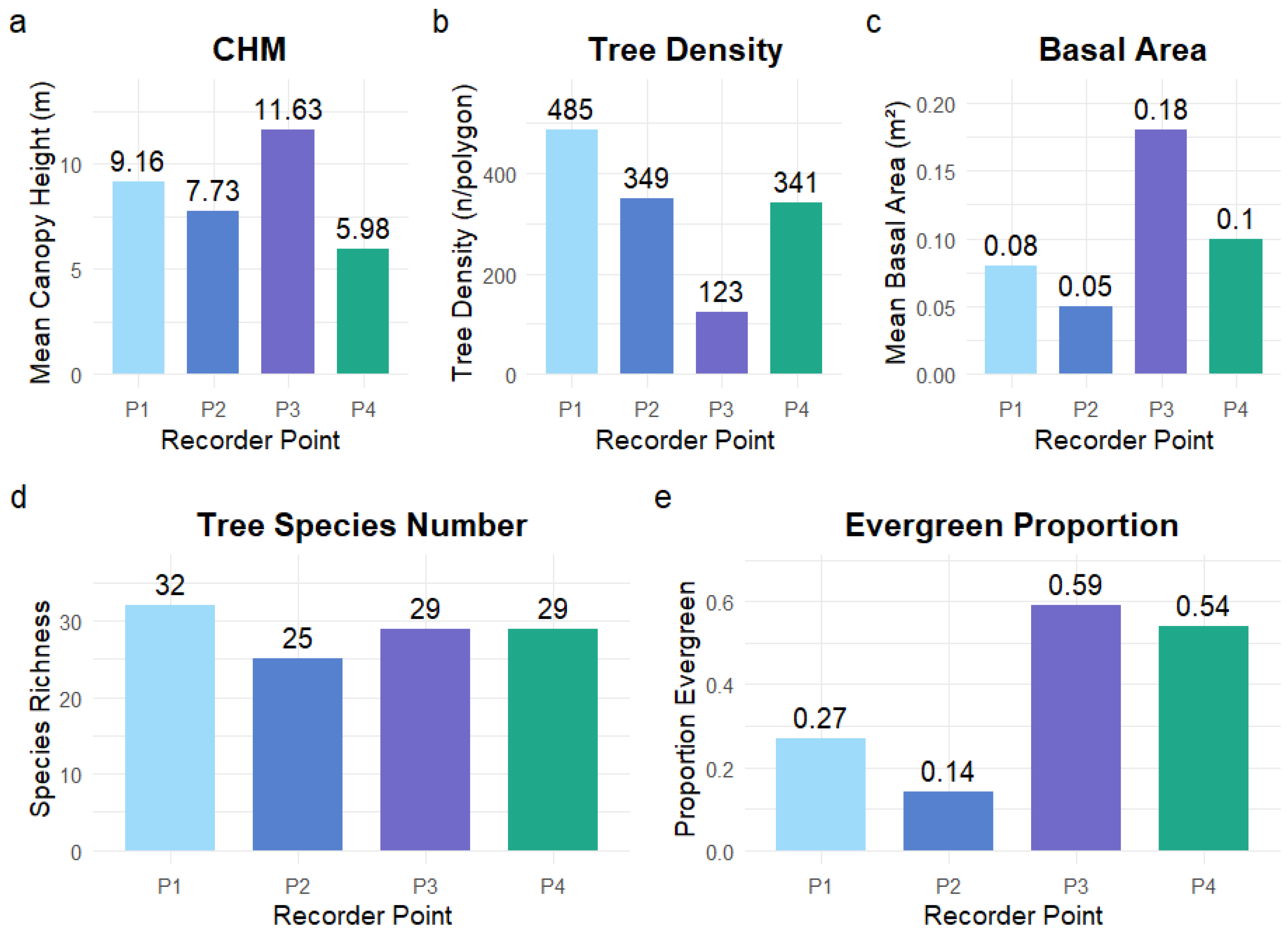
| Predictor | NDSI | ACI | AEI | ADI | BI |
|---|---|---|---|---|---|
| (Intercept) | 6.183 *** | 89.892 *** | 0.428 *** | 3.668 *** | 52.212 |
| Season: Autumn | 0.061 | −0.857 *** | −0.129 *** | 0.148 *** | −10.512 *** |
| Season: Spring | 0.238 *** | −0.676 ** | −0.214 *** | 0.231 *** | −27.533 *** |
| Mean temperature (C°) | 0.028 *** | 0.058 ** | 0.182 *** | −0.002 | 2.859 *** |
| Mean humidity (%) | 0.001 * | 0.009 * | −0.113 *** | 0.002 *** | 0.017 |
| Solar radiation (W/m2) | −0.0002 *** | −0.002 *** | 0.108 *** | −0.0001 *** | 0.016 *** |
| Barometric pressure (hPa) | −0.007 *** | −0.027 ** | 0.036 | −0.002 * | 0.041 |
| Conditional R2 | 0.415 | 0.123 | 0.300 | 0.159 | 0.430 |
| Marginal R2 | 0.394 | 0.20 | 0.068 | 0.089 | 0.171 |
| Recorder Location | Mean NDSI | Pairwise Comparison (Tukey HSD) | ||
|---|---|---|---|---|
| Contrast | Difference | p-Value | ||
| P1 | –0.295 | P2–P1 | 0.176 | <0.001 *** |
| P2 | –0.119 | P3–P1 | 0.054 | 0.071 |
| P3 | –0.241 | P4–P1 | 0.164 | <0.001 *** |
| P4 | –0.131 | P3–P2 | –0.122 | <0.001 *** |
| P4–P2 | –0.012 | 0.947 | ||
| P4–P3 | 0.110 | <0.001 *** | ||
| Recorder Location | Mean ACI | Pairwise Comparison (Tukey HSD) | ||
|---|---|---|---|---|
| Contrast | Difference | p-Value | ||
| P1 | 64.02 | P2–P1 | +0.87 | <0.001 *** |
| P2 | 64.88 | P3–P1 | –0.63 | <0.001 *** |
| P3 | 63.39 | P4–P1 | –1.62 | <0.001 *** |
| P4 | 62.40 | P3–P2 | –1.49 | <0.001 *** |
| P4–P2 | –2.49 | <0.001 *** | ||
| P4–P3 | –0.99 | <0.001 *** | ||
| Recorder Location | Mean AEI | Pairwise Comparison (Tukey HSD) | ||
|---|---|---|---|---|
| Contrast | Difference | p-Value | ||
| P1 | 0.392 | P2–P1 | +0.010 | 0.714 |
| P2 | 0.402 | P3–P1 | +0.001 | 0.999 |
| P3 | 0.393 | P4–P1 | –0.116 | <0.001 *** |
| P4 | 0.277 | P3–P2 | –0.009 | 0.796 |
| P4–P2 | –0.126 | <0.001 *** | ||
| P4–P3 | –0.117 | <0.001 *** | ||
| Recorder Location | Mean ADI | Pairwise Comparison (Tukey HSD) | ||
|---|---|---|---|---|
| Contrast | Difference | p-Value | ||
| P1 | 1.901 | P2–P1 | –0.020 | 0.452 |
| P2 | 1.880 | P3–P1 | +0.011 | 0.872 |
| P3 | 1.911 | P4–P1 | +0.192 | <0.001 *** |
| P4 | 2.093 | P3–P2 | +0.031 | 0.115 |
| P4–P2 | +0.213 | <0.001 *** | ||
| P4–P3 | +0.182 | <0.001 *** | ||
| Recorder Location | Mean BI | Pairwise Comparison (Tukey HSD) | ||
|---|---|---|---|---|
| Contrast | Difference | p-Value | ||
| P1 | 112.45 | P2–P1 | –1.24 | 0.855 |
| P2 | 111.20 | P3–P1 | +7.94 | <0.001 *** |
| P3 | 120.39 | P4–P1 | +49.21 | <0.001 *** |
| P4 | 161.66 | P3–P2 | +9.19 | <0.001 *** |
| P4–P2 | +50.45 | <0.001 *** | ||
| P4–P3 | +41.27 | <0.001 *** | ||
| Variable | Mean | SE | P1 | P2 | P3 | P4 |
|---|---|---|---|---|---|---|
| CHM | 8.624 | 0.033 | 9.16 | 7.73 | 11.63 | 5.98 |
| Tree Density (n/ha) | 324.700 | 2.049 | 485 | 349 | 123 | 341 |
| Basal area (m2) | 0.102 | 0.001 | 0.08 | 0.05 | 0.18 | 0.1 |
| Number of tree species | 28.756 | 0.039 | 32 | 25 | 29 | 29 |
| Proportion of evergreen species (%) | 0.385 | 0.003 | 0.27 | 0.14 | 0.59 | 0.54 |
Disclaimer/Publisher’s Note: The statements, opinions and data contained in all publications are solely those of the individual author(s) and contributor(s) and not of MDPI and/or the editor(s). MDPI and/or the editor(s) disclaim responsibility for any injury to people or property resulting from any ideas, methods, instructions or products referred to in the content. |
© 2025 by the authors. Licensee MDPI, Basel, Switzerland. This article is an open access article distributed under the terms and conditions of the Creative Commons Attribution (CC BY) license (https://creativecommons.org/licenses/by/4.0/).
Share and Cite
Portaccio, A.; Chianucci, F.; Pirotti, F.; Piragnolo, M.; Sozzi, M.; Zangrossi, A.; Celli, M.; Mazzella di Bosco, M.; Bolognesi, M.; Sella, E.; et al. Linking Acoustic Indices to Vegetation and Microclimate in a Historical Urban Garden: Setting the Stage for a Restorative Soundscape. Land 2025, 14, 1970. https://doi.org/10.3390/land14101970
Portaccio A, Chianucci F, Pirotti F, Piragnolo M, Sozzi M, Zangrossi A, Celli M, Mazzella di Bosco M, Bolognesi M, Sella E, et al. Linking Acoustic Indices to Vegetation and Microclimate in a Historical Urban Garden: Setting the Stage for a Restorative Soundscape. Land. 2025; 14(10):1970. https://doi.org/10.3390/land14101970
Chicago/Turabian StylePortaccio, Alessia, Francesco Chianucci, Francesco Pirotti, Marco Piragnolo, Marco Sozzi, Andrea Zangrossi, Miriam Celli, Marta Mazzella di Bosco, Monica Bolognesi, Enrico Sella, and et al. 2025. "Linking Acoustic Indices to Vegetation and Microclimate in a Historical Urban Garden: Setting the Stage for a Restorative Soundscape" Land 14, no. 10: 1970. https://doi.org/10.3390/land14101970
APA StylePortaccio, A., Chianucci, F., Pirotti, F., Piragnolo, M., Sozzi, M., Zangrossi, A., Celli, M., Mazzella di Bosco, M., Bolognesi, M., Sella, E., Corbetta, M., Pazzaglia, F., & Cavalli, R. (2025). Linking Acoustic Indices to Vegetation and Microclimate in a Historical Urban Garden: Setting the Stage for a Restorative Soundscape. Land, 14(10), 1970. https://doi.org/10.3390/land14101970












